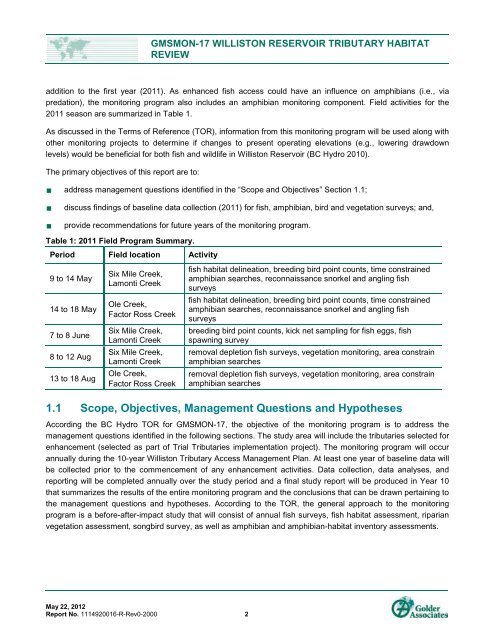GMSMON-17 WILLISTON RESERVOIR TRIBUTARY - BC Hydro
GMSMON-17 WILLISTON RESERVOIR TRIBUTARY - BC Hydro
GMSMON-17 WILLISTON RESERVOIR TRIBUTARY - BC Hydro
Create successful ePaper yourself
Turn your PDF publications into a flip-book with our unique Google optimized e-Paper software.
May 22, 2012<br />
Report No. 1114920016-R-Rev0-2000 2<br />
<strong>GMSMON</strong>-<strong>17</strong> <strong>WILLISTON</strong> <strong>RESERVOIR</strong> <strong>TRIBUTARY</strong> HABITAT<br />
REVIEW<br />
addition to the first year (2011). As enhanced fish access could have an influence on amphibians (i.e., via<br />
predation), the monitoring program also includes an amphibian monitoring component. Field activities for the<br />
2011 season are summarized in Table 1.<br />
As discussed in the Terms of Reference (TOR), information from this monitoring program will be used along with<br />
other monitoring projects to determine if changes to present operating elevations (e.g., lowering drawdown<br />
levels) would be beneficial for both fish and wildlife in Williston Reservoir (<strong>BC</strong> <strong>Hydro</strong> 2010).<br />
The primary objectives of this report are to:<br />
�<br />
�<br />
�<br />
address management questions identified in the “Scope and Objectives” Section 1.1;<br />
discuss findings of baseline data collection (2011) for fish, amphibian, bird and vegetation surveys; and,<br />
provide recommendations for future years of the monitoring program.<br />
Table 1: 2011 Field Program Summary.<br />
Period Field location Activity<br />
9 to 14 May<br />
14 to 18 May<br />
7 to 8 June<br />
8 to 12 Aug<br />
13 to 18 Aug<br />
Six Mile Creek,<br />
Lamonti Creek<br />
Ole Creek,<br />
Factor Ross Creek<br />
Six Mile Creek,<br />
Lamonti Creek<br />
Six Mile Creek,<br />
Lamonti Creek<br />
Ole Creek,<br />
Factor Ross Creek<br />
fish habitat delineation, breeding bird point counts, time constrained<br />
amphibian searches, reconnaissance snorkel and angling fish<br />
surveys<br />
fish habitat delineation, breeding bird point counts, time constrained<br />
amphibian searches, reconnaissance snorkel and angling fish<br />
surveys<br />
breeding bird point counts, kick net sampling for fish eggs, fish<br />
spawning survey<br />
removal depletion fish surveys, vegetation monitoring, area constrain<br />
amphibian searches<br />
removal depletion fish surveys, vegetation monitoring, area constrain<br />
amphibian searches<br />
1.1 Scope, Objectives, Management Questions and Hypotheses<br />
According the <strong>BC</strong> <strong>Hydro</strong> TOR for <strong>GMSMON</strong>-<strong>17</strong>, the objective of the monitoring program is to address the<br />
management questions identified in the following sections. The study area will include the tributaries selected for<br />
enhancement (selected as part of Trial Tributaries implementation project). The monitoring program will occur<br />
annually during the 10-year Williston Tributary Access Management Plan. At least one year of baseline data will<br />
be collected prior to the commencement of any enhancement activities. Data collection, data analyses, and<br />
reporting will be completed annually over the study period and a final study report will be produced in Year 10<br />
that summarizes the results of the entire monitoring program and the conclusions that can be drawn pertaining to<br />
the management questions and hypotheses. According to the TOR, the general approach to the monitoring<br />
program is a before-after-impact study that will consist of annual fish surveys, fish habitat assessment, riparian<br />
vegetation assessment, songbird survey, as well as amphibian and amphibian-habitat inventory assessments.
















